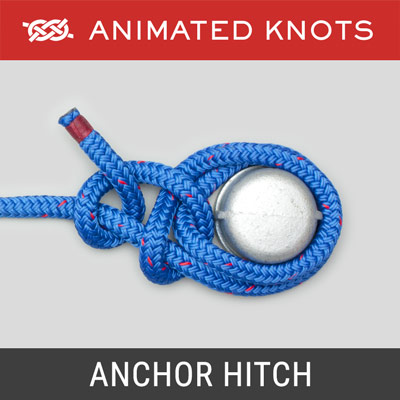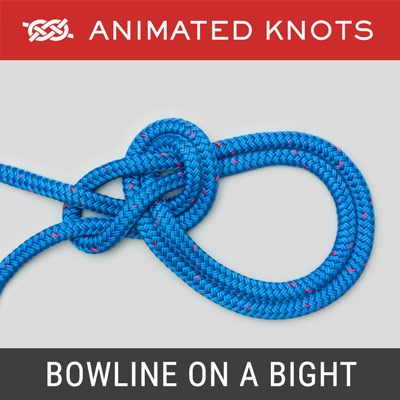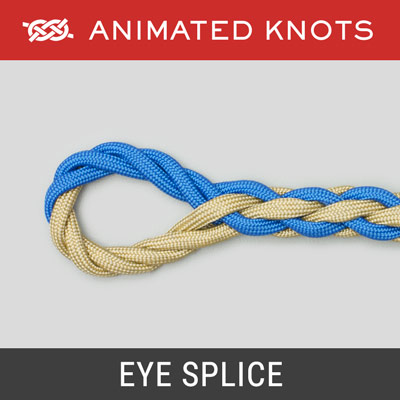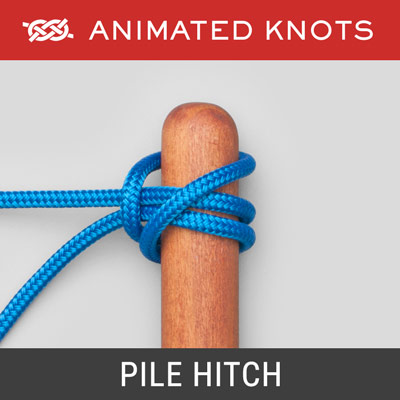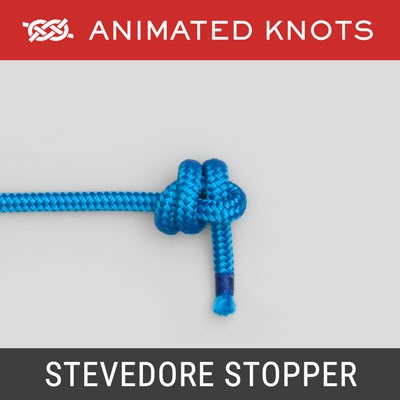No results found.
Welcome to Boating Knots
These animated knots are primarily for boaters, but many are useful for anyone who uses rope and values safety.
Selection
The selection of knots is based on many years of sailing combined with feedback and advice from several helpful captains. The knots are arranged in alphabetical order.
Boating Knot Characteristics
Rope used in boating is durable and expensive and is often handling heavy loads, e.g., when berthing, mooring, towing another vessel, preparing for a storm, or managing sails. The emphasis, therefore, is on safety, reliability, and convenience. In contrast to the fishing knots, value is also placed on being able to use the rope repeatedly and untie each knot without difficulty.
Standing End, Tail, and Bitter End
In many knots there is Standing End - which takes the strain, and a Tail - the loose end in your hand. On large ships a shore line is initially tightened with a winch. The tail is then properly called a Bitter End as it is transferred to the Bitts. To do this, a second rope is tied to the shore line with a Rat-Tailed Stopper or a Rolling Hitch to take the strain temporarily.
Mooring Lines and Names
Mooring lines on large ships are nearly always made of a high-modulus polyethylene (HMPE) such as Vectran® or Dyneema®. These ropes float and their minimal elasticity reduces risk of injury due to "snap-back" in the event of a breakage. Each line serves a specific purpose. On large vessels two lines often run in parallel ("doubled up") for safety. The following diagram shows a typical arrangement:
A. Head Line
B. Head Line
C. Forward Breast Line
D. Forward Spring
E. Aft Spring
F. Aft Breast Line
G. Stern Line
H. Stern Line
On yachts mooring lines are more likely to be made of nylon, or polyester (Dacron® or Terylene®). By contrast with mooring a large vessel, distances are usually small and movements due to waves and tide are proportionately greater. Moreover, because far fewer lines are used, it is critical to understand their purpose:
Breast Lines prevent rotation and should run roughly at 90o to the dock. To gain length, they should be led from the farthest part of the boat: the bow itself (or the outer hull of a catamaran) and from the far quarter of the stern.
Spring Lines prevent fore and aft movement and should run nearly parallel to the dock and may cross each other to obtain an optimal lie.
Direction: The Bow Spring may be led forwards and the Stern Spring aft, but MUST lead in opposite directions.
1. Bow Breast Line
2. Bow Spring Line
3. Stern Spring Line
4. Stern Breast Line
Doubling-Up and Sharing a Bollard
When two lines run to the same Bollard, especially when they are from different ships, the second line should be threaded up through the eye-splice of the first. This is called Dipping the Loop and allows either line to be released with out tangling.
Which Knot Should I Use?
Joining Two Ropes
Secure safe bend to join two ropes
Secure safe bend to join two ropes
Attach rope to itself or another taut line
Join 2 ropes using a loop in each end
Take the strain off a foul-turned winch
Take the strain of mooring line
Join two very large ropes
Secure "spring" lines - readily adjusted
Make a Loop at End of Rope
Make a loop in the end of a rope
Adjustable Loop using Rolling Hitch
Splice a loop in a three-strand rope
Make a Loop in Middle of Rope
Single loop in middle of rope
Double loop in middle of rope
Loop Round Standing End
Bowline slides up rope as a noose
Attach Halyard
Cleat Hitch
Halyard Hitch
Secure Rope to Flapping Sail
Buntline Hitch
Soft Shackle
Secure a Load or Tarpaulin
Tighten Using a Trucker's Hitch
Secure Mooring Line to Dock
Secure mooring line to a cleat
Wrap mooring line round post and tie it
Make a loop to drop over the dock post
Tie a dinghy bow line to a rail or ring
Secure mooring line – easily undone.
Quickly secure mooring line to post
Attach Rope to your anchor
Attach rope to your anchor
Secure, permanent rope splice to chain
Stopper Knots
Larger three-lobed stopper knot
Secure compact stopper
Quick convenient stopper
Secure even in Dyneema
Secure Stopper Knot
Slide and Grip (Friction) Knots
Knot that won't slide along a rope
Knot that won't slide along a bar
Grips strongly on a pole
Weight a Rope's End for Throwing
Heaving Line Knot
Stop a Rope's End Fraying
Drop a Constrictor Knot on the End
Miscellaneous
Attach a fender to the rail
Shackle using rope
Better soft shackle
Related Knots
Four similar bends:
Alpine Butterfly
Ashley
Hunter's
Zeppelin
Three quick-release hitches:
Highwayman's
Mooring
Tumble
Three stopper knots:
Ashley
Double Overhand
Figure 8
Three ways to tie the Clove Hitch:
Half Hitches
Loops
Using the End
Three ways to tie the Constrictor:
Twisting the Rope
Using the End
Folding a Loop


